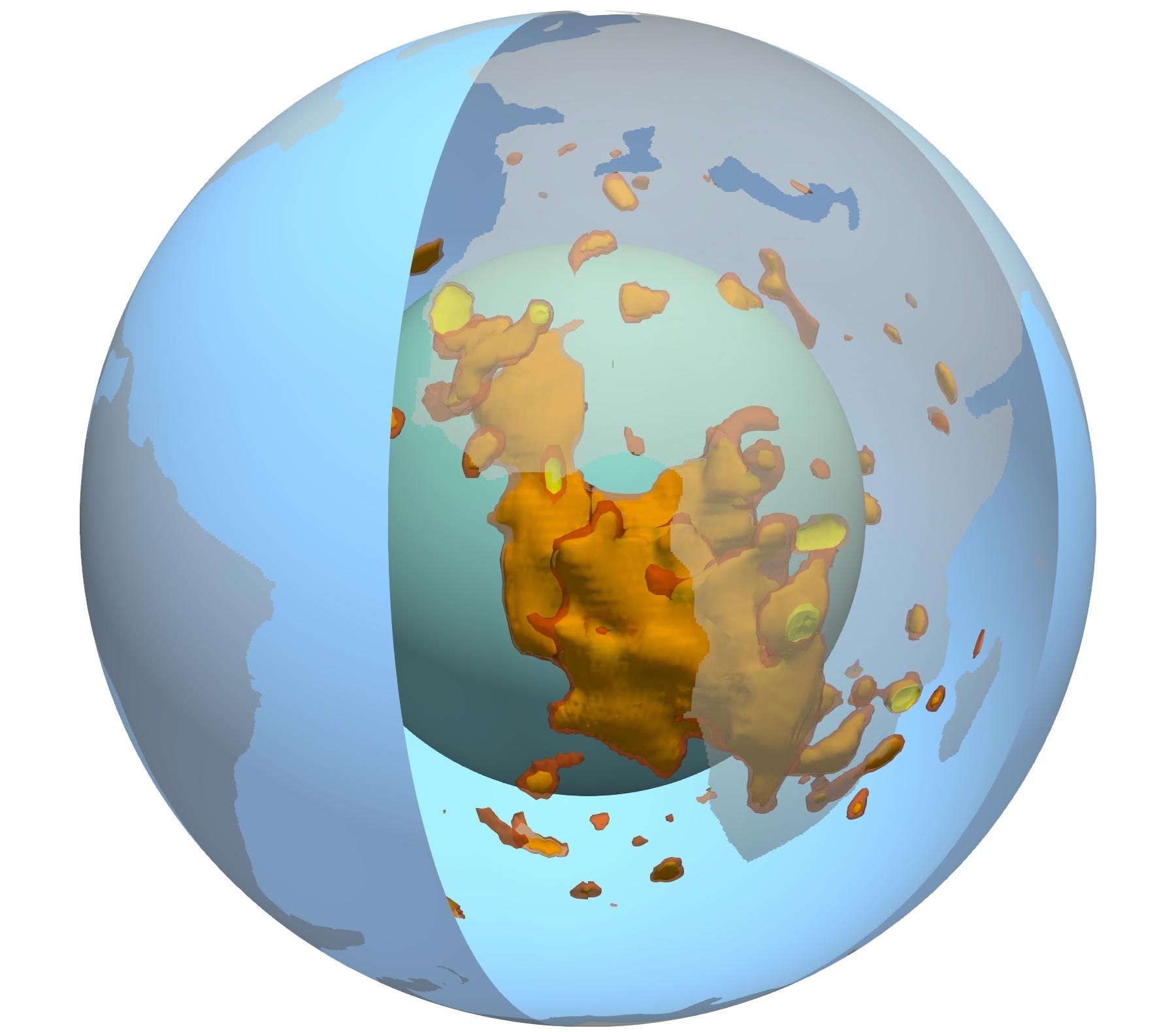Tampilan 3D dari lapisan mantel bumi di bawah Afrika, yang diwakili oleh warna merah-kuning-oranye. Warna cyan mewakili batas inti-mantel, permukaan biru, dan benua abu-abu transparan. Kredit: Mingming Li/ASU
Bumi berlapis seperti bawang, dengan kerak luar tipis, mantel kental tebal, inti luar cair, dan inti dalam padat. Di dalam mantel ada dua struktur mirip gumpalan besar yang secara kasar berada di sisi berlawanan dari planet ini. Lebih dikenal sebagai Provinsi Kecepatan Geser Rendah Besar (LLSVPs), gumpalan tersebut masing-masing seukuran benua dan 100 kali lebih tinggi dari Gunung Everest. Satu terletak di bawah benua Afrika sementara yang lain terletak di bawah Samudra Pasifik.
Dengan menggunakan instrumen yang mengukur gelombang seismik, para ilmuwan mengetahui bahwa kedua gumpalan ini memiliki bentuk dan struktur yang rumit, tetapi terlepas dari ciri-cirinya yang menonjol, sedikit yang diketahui tentang mengapa gumpalan itu ada atau apa yang menyebabkan bentuknya yang aneh.
Ilmuwan Arizona State University Qian Yuan dan Mingming Li dari School of Earth and Space Exploration ingin mempelajari lebih lanjut tentang dua gumpalan ini menggunakan pemodelan geodinamik dan analisis studi seismik yang dipublikasikan. Penelitian mereka memungkinkan mereka untuk menentukan ketinggian maksimum yang dicapai gumpalan dan bagaimana volume dan kepadatan gumpalan, serta viskositas di sekitar mantel, dapat mengontrol ketinggiannya. Hasil penelitian mereka baru-baru ini dipublikasikan di
The results of their seismic analysis led to a surprising discovery that the blob under the African continent is about 621 miles (1,000 km) higher than the blob under the Pacific Ocean. According to Yuan and Li, the best explanation for the vast height difference between the two is that the blob under the African continent is less dense (and therefore less stable) than the one under the Pacific Ocean.
To conduct their research, Yuan and Li designed and ran hundreds of mantle convection models simulations. They exhaustively tested the effects of key factors that may affect the height of the blobs, including the volume of the blobs and the contrasts of density and viscosity of the blobs compared with their surroundings. They found that to explain the large differences of height between the two blobs, the one under the African continent must be of a lower density than that of the blob under the Pacific Ocean, indicating that the two may have different composition and evolution.
“Our calculations found that the initial volume of the blobs does not affect their height,” lead author Yuan said. “The height of the blobs is mostly controlled by how dense they are and the viscosity of the surrounding mantle.”
“The Africa LLVP may have been rising in recent geological time,” co-author Li added. “This may explain the elevating surface topography and intense volcanism in eastern Africa.”
These findings may fundamentally change the way scientists think about the deep mantle processes and how they can affect the surface of the Earth. The unstable nature of the blob under the African continent, for example, may be related to continental changes in topography, gravity, surface volcanism and plate motion.
“Our combination of the analysis of seismic results and the geodynamic modeling provides new insights on the nature of the Earth’s largest structures in the deep interior and their interaction with the surrounding mantle,” Yuan said. “This work has far-reaching implications for scientists trying to understand the present-day status and the evolution of the deep mantle structure, and the nature of mantle convection.”
Reference: “Instability of the African large low-shear-wave-velocity province due to its low intrinsic density” by Qian Yuan and Mingming Li, 10 March 2022, Nature Geoscience.
DOI: 10.1038/s41561-022-00908-3

“Ninja twitter bersertifikat. Ahli internet. Penggemar budaya pop hardcore. Baconaholic.”

